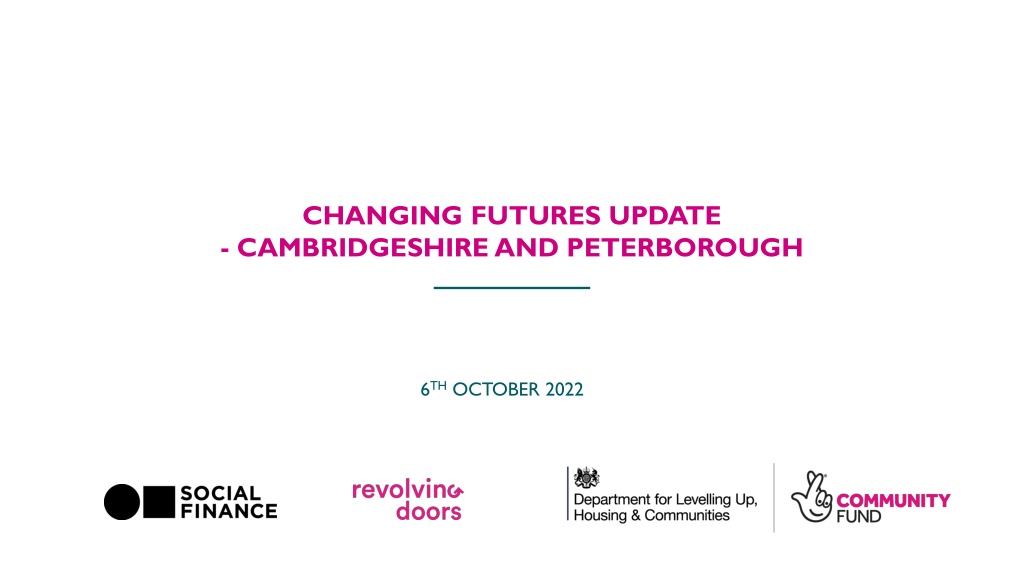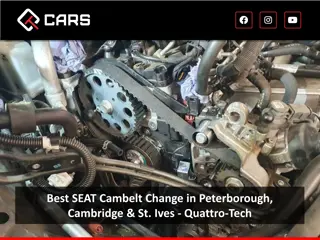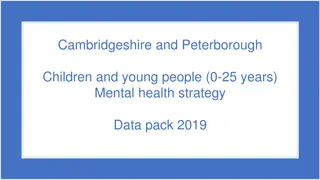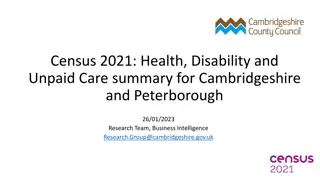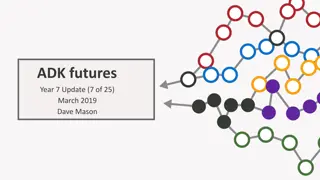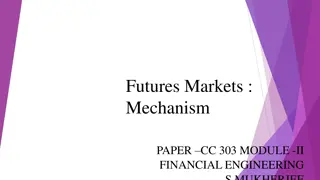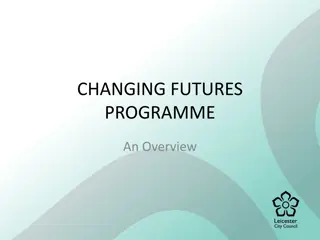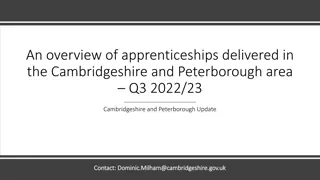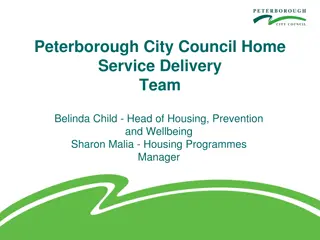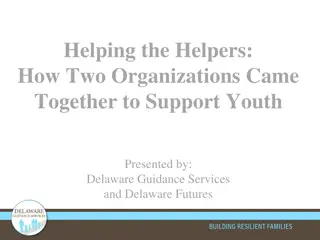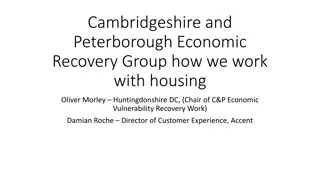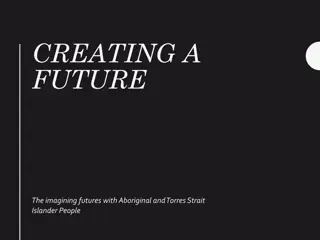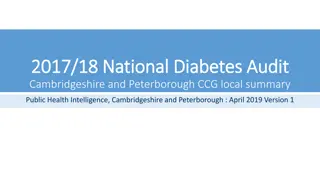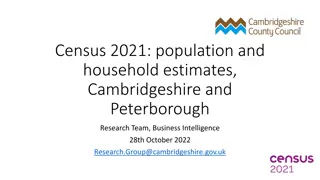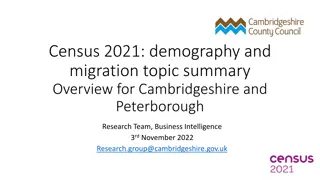Changing Futures Update: Overview of Support Programs in Cambridgeshire and Peterborough
This update provides insights into the support programs offered in Cambridgeshire and Peterborough, focusing on areas such as co-production, systems change, data management, and partnership working. The overview covers the support structure, learning sessions, thematic areas, and communities of practice to enhance expertise and sustained impact.
Download Presentation

Please find below an Image/Link to download the presentation.
The content on the website is provided AS IS for your information and personal use only. It may not be sold, licensed, or shared on other websites without obtaining consent from the author. Download presentation by click this link. If you encounter any issues during the download, it is possible that the publisher has removed the file from their server.
E N D
Presentation Transcript
CHANGING FUTURES UPDATE - CAMBRIDGESHIRE AND PETERBOROUGH 6THOCTOBER 2022
CONTENTS 2 1. Overview of Area and National Support Offer 2. Overall Learnings 3. How to measure progress 4. Example Learning Systems 5. Data Learnings
OVERVIEW CF VS. MEAM SUPPORT 3 Mixture of MEAM and FL / CF Changing Futures Only New MEAM Areas MEAM/CF FL / CF Windsor and Maidenhead Oxfordshire Buckinghamshire Herefordshire v Medway Essex Northumbria Stoke Surrey Somerset Cumbria Hertfordshire Lincoln Original MEAM areas Sheffield Sussex Bristol S Tees North Windsor and Maidenhead Basingstoke Calderdale Cambridgeshire Durham Lincolnshire Leicester Southend on Sea Redcar and Cleveland Lancashire Westminster Peterborough Reading West Yorkshire Redbridge Norwich Hackney Camden Cornwall Stafford Greater Manchester Hull York Exeter Middlesborough North Devon Haringey Newham Plymouth Nottinghamshire
OVERVIEW OF OUR SUPPORT 4 Dedicated Area Support Lead within the Social Finance / Revolving Doors team Guided reflection sessions, helping areas take a birds eye view of their programme and challenging areas on their thinking, and explore any areas where further support could be offered End-to-end support including: helping areas set their vision for the programme through guided workshops, helping areas mobilise through support with recruitment, onboarding and training, and helping areas develop their ambition through support prioritising their systems change objectives, building partnership buy-in, and embedding coproduction A few areas also receive deep-dive support to help them determine the root drivers of systemic problems impacting on people experiencing multiple disadvantage Local Support National Support We provide support on themes including co-production, systems change, data + digital, partnership working and commissioning, as well as thematic areas linked to Multiple Disadvantage We lead regular guided learning sessions to support areas build their expertise in these topics, combining tutorials, case studies, and peer-to-peer learning Every quarter, we bring together the wider Changing Futures partnership for National Learning Events, which are day long events with keynote speakers, opportunities for networking and workshops on themes including: pushing the envelope on systems change, deliberative problem solving, and how to sustain impact As well as this, we coordinate four Communities of Practice for: Senior Responsible Officers; Partnership Leads; Lived Experience Leads and Data Leads, with a new Community of Practice being set up for Systems Change and Learning Leads
OVERALL LEARNINGS TO DATE (1/2) 5 1. Changing Futures core teams operate similar to a backbone organisation in a Collective Impact model Effective backbone support has been shown to be a critical condition for achieving collective impact that is the impact made by a network of organisations, community members and institutions who work as equal partners to advance equity and create better system outcomes. The backbone provides: vision and strategy for other partners, supports aligned partner activities, establishes shared measurement practices, builds public will, advances policy and mobilises funding. 2. Areas have often found it challenging to recruit to systems change lead roles Areas are more successful with recruitment when they broaden their remit to consider the wider transferable skills required for these roles, rather than simply looking for people with previous exposure to system change work or multiple disadvantage. Transferable skills could include programme management, ability to understand complexity and ability to work across organisational boundaries. One area refined its approach to recruitment and managed to find a perfect fit: an engineer by practice in the Ministry of Defence. The Value of Backbone Organizations in Collective Impact - Collective Impact Forum
OVERALL LEARNINGS TO DATE (2/2) 6 3. Building partnerships for change takes time to get right In building the partnership, it can be quite easy and a default to take things for granted, e.g., buy in from stakeholders, and as a result push the programme forward without people having full understanding of what they are signing off. However, without more explicit agreement and engagement earlier on this risks the pace of progress down the line. It s important to ensure in seeking buy in, partnership stakeholders ask questions and are given time to consider what they are buying into. Set clear expectations from what you want your stakeholders to do and achieve both individually and together
HOW DO THEY MEASURE PROGRESS OF THEIR WORK AGAINST KEY PRINCIPLES 7 * Templates to capture qualitative insight on the extent to which you are working in line with your programme principles can be useful tool to capture qualitative insight on the partnership on an ongoing basis We have developed a learning case study template to support areas to reflect on what they re learning in their partnerships and how their local ecosystem culture shifting. Our healthy partnership tool is a framework areas can use to reflect on how their system change partnerships are performing Some areas are also exploring the Barrett Centre approach: Barrett Values Centre | Your Organization, Thriving
USE THIS FRAMEWORK TO THINK ABOUT THE STRENGTH OF YOUR STRATEGIC PARTNERSHIP 8 Ingredients of successful system change partnerships What does it look like when you re succeeding? Suggested activities and approaches Shared approach to measuring success Vision workshops to align Common data dashboard Jointly written/agreed sustainability plan Partnership newsletter Strong internal communication between partners ALIGNED Clear common vision for change Clear understanding of roles and purpose Shared understanding of MD Culture of trust and authenticity Prioritise face-to-face Diversity of facilitation approaches Cultivating 50/50 spaces (inc LE Chairs) Respectful rather than professional language Strong interpersonal relationships HUMAN Shared, articulated values and norms Open and honest dialogue Inclusive spaces that pay attention to power Meaningful involvement of LE Mechanisms to ensure learning Regular reflection points how well the partnership is working Regular 1:1 check in with partners for feedback Learning away days and learning logs Willing to change direction and be challenged SELF- LEARNING Co-production at the heart of the work Safe and challenge and test assumptions Comfort with risk and failure Mechanisms for self-reflection & adaptation Accountability mechanisms Culture of initiative-taking by members Senior and/or rotating Chair Connecting between meetings for updates Accountability, e.g. like a buddy system Targeted working sub-groups Attendees' senior enough to influence system Consistent attendance IMPACTFUL Broad representation across system Partners are testing new approaches in their own organizations + wider system Strong leadership
TEMPLATE: WHAT ARE YOU LEARNING FROM CHANGING FUTURES 9 Interview question Prompt Question Overall, how well do you think your system is listening, learning and adapting What changes are you noticing in the lives of individuals in the cohort? What changes are you noticing in the way services are working, either with each other, or with service beneficiaries? What new voices are you listening to? What new stakeholder are in the room now? What changes have you noticed in the way stakeholders across the system are coming together to listen and learn from each other and make system-wide change? What have you learnt? About yourself? About the system? How have you adapted? What changes have you noticed in yourself? In others? In the way the system works? How has the pace or nature of local transformation shifted under Changing Futures (if it has at all?) What has caused these changes and what needs to happen to make them sustainable longer term?
OUTCOMES FRAMEWORK 10 Category Definition How to measure These are programme or service activities which are done to address a need. These measures can be counted. Activity Measures Quant measure assessing the number of things that are produced and can be counted Will help demonstrate spread and scale of intervention, e.g. take-up More traditional approaches e.g. statistical surveys, data collation, data analysis, cost- benefic analysis Output Measures Quant measurement of the impact of the intervention. Can help clearly and numerically demonstrate what is working and how. Quantitative Outcomes Mainly Qual measurement capturing people, staff and stakeholders experiences of intervention. Real-time' feedback, citizen panels, cohort studies, interviews, focus groups, qualitative surveys, case studies, testimonies, story-telling, workshops, legislative theatre, peer-led research, ethnography, video narratives Relational or Qualitative Outcomes Can help uncover stories behind why certain interventions are working and others are not
Note: List of example measures are not exhaustive 11 Include: To what extent are we delivering with fidelity to principles
CAPTURE UNDERSTAND & ACTION AUDIENCE / LENS METHOD Co-production Groups Programme Board meeting (quarterly) People with Lived Experience Virtual Learning Logs Insights Session Frontline Staff Project Deliverables Analysis & Affinity Synthesis MDSC Meetings Highlight Report Template @ Programme Group meeting (quarterly) Learning & Reflection Sessions Programme / Project Team(s) CoPs Programme Insights [Log] CF National Partnership & Consortium Performance & Impact Framework Performance & Impact Data TBC Research
CAPTURE UNDERSTAND & ACTION REVIEW & FEEDBACK Programme Board meeting (quarterly) Performance & Impact Framework - Core Measures Programme Analysis & Affinity Synthesis Required at these stages (secondary) Learning Measures Programme / Project Work Project Deliverables Insights Session Programme Insights [Log] DLUHC Quarterly Report (e.g. VAWG systems mapping, reports, etc) MDSC Meetings Programme Comms @ Programme Group meeting (quarterly) Highlight Report Template Learning & Reflection Sessions Action(s) - as directed by MDSC Prompting questions / lines of enquiry Activity / Action Frontline Experiences Virtual Learning Logs Product
LEARNINGS FROM THE DATA AND DIGITAL WORK ON CHANGING FUTURES 15 Key insights and learnings Plymouth: shifting from tech-first to user-first As part of their remit for Changing Futures, Plymouth have been considering creating a digital app for people with lived experience, living in the city. This was a top-down decision to create a tech-first solution. However, the CF data team have recognized there is greater impact in putting user-needs first and that there is a bigger opportunity around getting agencies to work more effectively together, which can be enabled by tech. Easier to know what data service users want and find meaningful compared to other stakeholders such as operational staff and/or senior leadership. This can present challenges in knowing what data to communicate to stakeholders and how to do it effectively. If data collected for staff is not linked with what service users care about, it limits the justification to collect that data. 1 2 Building spaces for peer-to-peer learning or sharing, and connecting people with similar approaches or technology has been integral to supporting CF delivery To sustain data transformation for multiple disadvantage it does not always require more data collection or analysis, or new technological change, often it requires greater collaboration across partners who continually look at user- needs first. 3 Plymouth s leadership would like support on how to thoughtfully understand their data problem and think differently about tech and its role in local data transformation. There is growing interest to find new ways to powerfully communicate data analysis which aligns better with what people want to do and who they want to communicate the data for
CHALLENGES ON DATA TO PROGRESS UNDERSTANDING AND OUTCOMES ON MULTIPLE DISADVANTAGE 16 A range of barriers exist across Changing Future areas depending on where they are in their data journey. The main barriers are: Other challenges include: - Supporting practitioners on how to ask questions of service users to prevent bias during data collection - Developing analytical skills Case management systems Data sharing agreements Getting the right people involved Meaningful analysis MD requires partnership across organizations and departments e.g., housing and criminal justice but there are challenges in getting DSA s in place. This includes setting up new agreements or extending existing agreements to include new partners - Designing alternative data visualization MD is not always embedded in local system change plans and areas hope to understand who the relevant data stakeholders are to engage with, to raise the profile of MD work locally and nationally Some CF areas are in the process of procuring case management solutions and are trying to understand the feasibility of different delivery approaches or considerations for how these systems make use of data CF areas intend to map system change objectives directly with data collected and understand how data can be best analyzed and shared even when it s limited - Getting teams to switch to new tools, CMS s and systems - Supplementing quantitative data e.g., on access and referrals with qualitative insight
